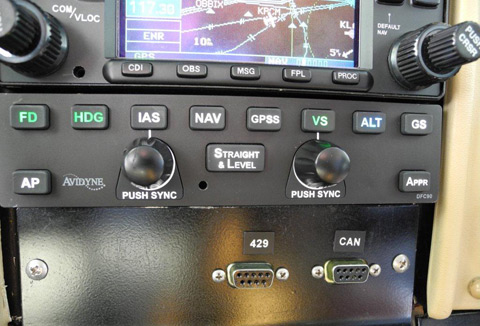
Aspen Avionics has made collaboration—including with competitors—a key part of its brand and culture. The Albuquerque-based company announced a partnership more than a year ago with Bendix/King for developing the interface of the KSN770 flight management system, even though Bendix/King makes primary flight displays and other cockpit displays that may compete with Aspen’s Evolution line of low-cost primary and multifunction displays.
More recently, Aspen has worked closely with Avidyne Avionics—another maker of glass cockpit systems—to hone the interface between its systems and the new Avidyne DFC90 digital autopilot.
Aspen President John Uczekaj says the relationship makes sense because Aspen doesn’t plan to get into the autopilot business and he was impressed by the Avidyne autopilot. As a former developer of flight management systems for Honeywell Aerospace, Uczekaj says the DFC90 provides capabilities and functions that rival those of flight control systems found in air transport category airplanes.
AOPA Pilot had the opportunity to fly behind the DFC90 in an Aspen-owned Cirrus SR22 replete with three Aspen Evolution displays. The attitude-based DFC90 gets its position information from the Aspen attitude-heading reference system. In return, the DFC90 sends mode information back to the Aspen system, where it is displayed for the pilot at the top of the PFD.The DFC90 is meant to be a slide-in replacement for the S-Tec Fifty-Five X autopilot, which is a rate-based system. While highly reliable, rate-based autopilots, which derive most of their position information from a turn coordinator, do not fly airplanes, especially fast ones, as crisply as an attitude-based autopilot. In fact, based on our demonstration, the DFC90 crisply flies the Cirrus even under highly challenging circumstances. To test the autopilot, we flew a 90-degree intercept to the inbound course of an RNAV approach at 170 knots true airspeed—and about 178 knots groundspeed. While most autopilots would struggle to intercept crisply under such circumstances, the DFC90 smoothly made the turn onto final, straying left of course about a quarter of a dot for only a few seconds. At glideslope intercept, the airplane smartly descended with minimal porpoising as it locked on to the signal at high speed.
The DFC90 provides a host of new features that help reduce pilot workload and improve safety. For example, as we dramatically demonstrated in an exclusive AOPA Live video the “Straight & Level” button provides one-touch recovery from unusual attitudes when the autopilot is off. Find yourself in the clouds and spiraling downward? Hit the button, and the autopilot will roll the airplane level and pitch the nose up.
When the autopilot is on, an Envelope Protection system works hard to eliminate autopilot-induced stalls and overspeeds. If the pilot commands a climb rate or speed that is not sustainable, for example, the autopilot will pitch the nose down to prevent a stall, allowing the airplane to descend if necessary to maintain a safe speed. The full-time Envelope Alerting system protects against flight envelope exceedances by providing visual and aural warnings to the pilot, even when the autopilot is not engaged. For example, an excessive bank angle will cause a visual alert on the PFD and an aural alert through the headphones. Flap and gear speed exceedances can also be annunciated.
Another feature frequently found only on high-end autopilots is the ability to climb and descend at a selected indicated airspeed, useful for fitting in well with other high-performance traffic in busy airspace.
The DFC90 is already certified for installation in early Cirrus models that don’t have the Garmin G1000 cockpit. Certification efforts on the Cessna 182 are well under way. Avidyne officials report that a V-tail Bonanza will be arriving at their facility on April 2 to begin testing that will lead to certification in that model over the next few months. Other models will follow after that.



